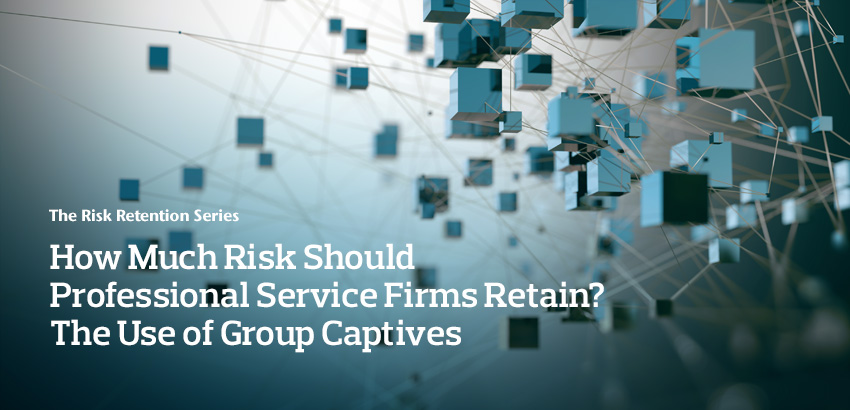Aon | Professional Services Practice
The risk retention series:
How much risk should professional service firms retain?
The use of group captives
Release Date: September 2021
Aon’s Professional Services Practice share insights to help firms navigate a hardening insurance market in the fourth article in a series exploring risk retention.
A previous article “How much risk should professional service firms retain? The use of single parent captives” provided some definitions, outlined the different types of captives and discussed single parent captives. This article will explain the benefits and challenges of group captives.
A group captive is a specific type of captive structure. A group captive, also known as an association captive, is owned by its members or insureds. It is created and functions much the same way as a single parent captive except, as seen below, it is owned not by single firm, but by multiple homogenous or heterogenous firms.
A major difference between the single parent and group captive, is capital funding. The capital for a group captive is contributed by multiple members rather than a single parent firm. All members share in the ownership of the captive and all members share the risks and the rewards of the structure.
Benefits of group captives
In order to properly reap the rewards from a group captive, it is important to understand the elements that make a group captive successful.
A group captive has a long term, strategic objective. It is primarily focused on overall substantive benefits rather than immediate savings. Members that form a group captive often share a strong group affinity, demonstrated by their willingness to share the losses of any of the members. Risk management and claims handling information is sometimes shared among the members to their mutual benefit, in addition to a portion of each member’s risk (usually at the primary layer). Sharing risks in this way creates new market capacity and still allows access to support from the reinsurance market. A group captive with the appropriate size and significant headcount can generate internal credibility for its own success as well as attracting interest from the external marketplace.
Governance is an important feature of successful group captives. The governance standards set out in formation documents and by-laws should reflect the meeting of the minds of members. As part of these by-laws and formation documents, members should create protocols for entry and departure which helps avoid rapid exits or entry from the group, thereby maintaining its strategic, long-term focus. Members’ long-term commitment also gives access to a growing capital base. Group captives can earn underwriting income and investment income just like any insurance company. If there is a profit, the captive can retain it for expanded risk capital or return it to the members as dividends.
Challenges to consider
Along with the benefits come challenges. As previously mentioned, a group captive is funded by its members. This means a captive will require capital to support risk levels. Both one-time and annual set-up and operational costs must be shared among the members. Once established and capitalized, members must agree on various decisions to properly manage the captive.
One important decision relates to confidentiality. While it is beneficial to share risk, the degree and extent of the sharing of risk management and loss information must be discussed and agreed among members. The level of such sharing will influence captive operations.
Even among like-minded peers there will be different attitudes towards insurance needs. The members’ risk and loss profiles vary. The sharing of risk can create acute awareness of these differences. Underwriting and investment profit benefit the members, but also present challenges, as there may be differing views on how the group captive should retain profit. Should they supplement capital reserves or distribute it back to members?
Tax issues must also be taken into consideration when forming and operating a group captive. It is likely that tax authorities will view a group captive favorably but there may still be issues dependent upon specific details.
In order to meet these challenges, the partners and employees of the member firms must be willing to allocate time and resources toward the decision-making and management of the captive. Group captives can take up significant amounts of time during their formation and on-going management. Although there are varying levels of member firm involvement, this issue must be discussed when creating a group captive.
A group captive can be an effective tool with the right firms and mind-set. Any firm considering the establishment of a group captive (or any captive) should undertake a captive feasibility study to better understand the type of captive that best meets their needs and goals for risk retention.
Aon’s Professional Services Practice values your feedback. If you have any comments or questions, please contact Connor Galvin.
Connor Galvin
Vice President and Director
Radnor

